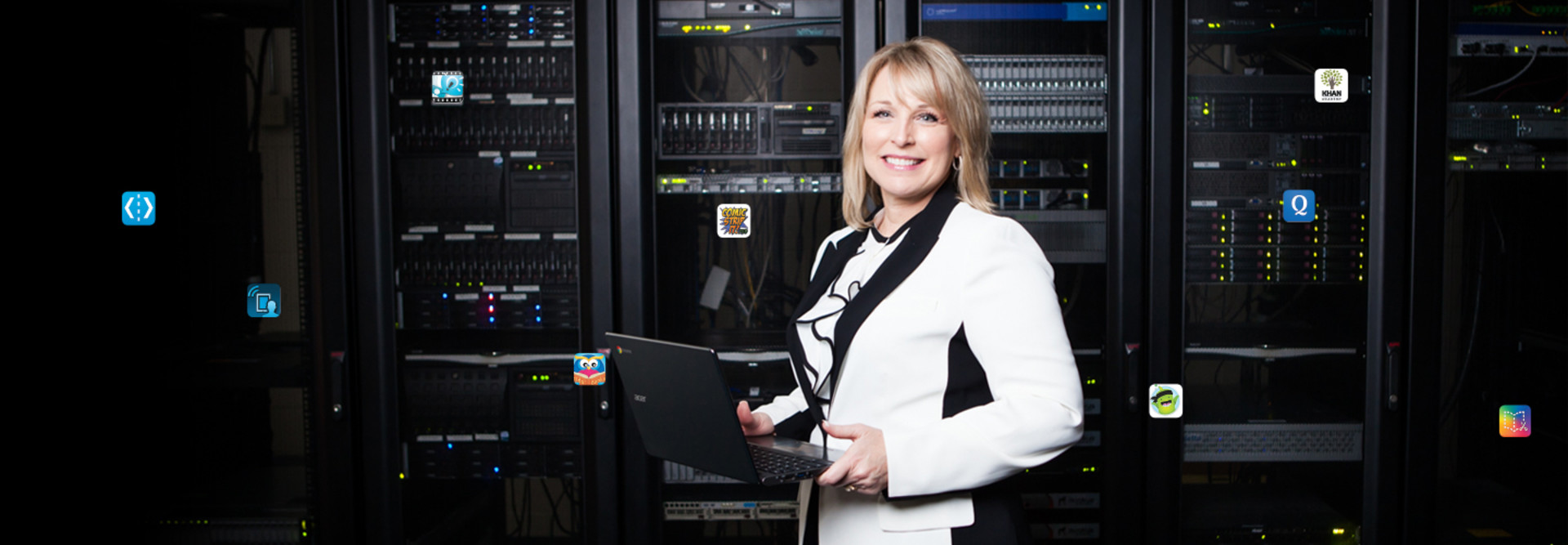Chromebooks + Google Apps for Education = Cloud-Friendly Classrooms
Ask Katie Russell of Barbers Hill Independent School District in Texas what teachers and students gain from the major Google Cloud rollout her IT team has under way, and she has a simple answer: collaboration and differentiated learning.
Since becoming the first school district in the state to implement a full Google solution, including Nexus tablets, Chromebooks and Google Apps for Education, Barbers Hill ISD has seen students and teachers enthusiastically embrace the technology.
When incorporating new technology into a curriculum, staff development is essential. With these tools, “the gap between discomfort and success is very narrow,” says Russell, Barbers Hill ISD’s director of technology.
Teachers in the district have found that the Chromebooks, combined with the sweep of apps available through Google Apps for Education (GAFE), let them tailor programs to individual students more easily than through traditional classroom instruction, Russell says. “We are off to a very rewarding start to this ongoing project and look forward to building future successes.”
Working Together
Collaborative is not a synonym for technology-enabled, says Kelly Calhoun, education research director for Gartner. “Collaboration in the classroom can take a million different forms, many of which don’t involve technology at all,” she says.
But many technologies, such as apps served via the cloud, lend themselves well to creating or enhancing a collaborative environment. “The advice I always give is to begin with some fairly specific outcomes in mind,” Calhoun says. “Lead with those instructional outcomes.”
This proves to be cost-effective, she says, because by focusing on teaching goals, school districts can avoid buying technology until they have a solid plan for how to use it.
It also lets a district’s leaders, teaching staff and IT team evaluate the best technology approach for its programs. Schools have a wealth of new tools to choose from — everything from interactive whiteboards and touch-screen monitors to tablets and 3D printers. The districts that best implement technology, Calhoun says, are those that focus on how the tech tools will let teachers deliver something in the classroom that they otherwise could not.
Increasingly for school districts such as Barbers Hill ISD and others, Google’s suite of tools combined with tablets and Chromebooks is helping teachers do just that.
Ready to Teach
Just weeks into the rollout of Google Classroom in California’s Salinas Union High School District, nearly a quarter of the more than 600 teachers in the district are using it on at least a weekly basis.
The Google tool helps teachers create and organize assignments, tapping into GAFE as they go. It’s already changing the way students and teachers interact across Salinas Union HSD, says Paul Scavo, an educational technologist for the district.
“Students feel empowered when they can explain the technology to their peers — and sometimes to the teacher,” he says. And teachers love the ability to live-view student work in progress and provide help when needed, whether during or outside of class hours, he says.
The number of Chromebooks Barbers Hill ISD can procure for roughly the cost of a single notebook or classroom workstation, including audio-visual as well as accompanying software
From Scavo’s perspective, one of the biggest keys to the district’s early success was its emphasis on professional development for its teachers. Scavo notes that the school district prepared to implement the new technologies by purchasing a limited number of Chromebooks last year and asking tech-savvy teachers to experiment with them in their classrooms.
This beta group turned into advocates for the tools, and some became “Chromebook champions,” who spend time daily using the devices in their classrooms.
To further drive adoptions, Scavo also organized a teacher technology showcase over the recent winter break. “I have been to many show-and-tell technology conferences over the years, and I usually walk away thinking, ‘That was a great presentation, but what does that look like in my classroom?’ I also walk away thinking, ‘Our teachers can do presentations as well as anyone I have seen.’ ”
Keeping these thoughts in mind, he created a conference in which Salinas Union HSD teachers were both the attendees and the presenters, and from which they all were able to leave with a solid understanding of how to implement the new technologies available to them immediately upon return to their classrooms.
Setting the Stage
Once Barbers Hill ISD had decided on its all-Google cloud strategy, Russell knew her team had to take a hard look at its back-end network. Bringing “always connected” devices such as tablets and Chromebooks into the infrastructure made it critical to ensure that the network could effectively handle these connected devices throughout the day, Russell says.
To do that, the district has been upgrading its school campuses with new Cisco Systems switches and Ruckus Wireless equipment. Barbers Hill ISD has completed the rollout at its elementary and middle schools and will finish up its high school this summer.
As the Google solution has become effective, it has expanded rapidly. What initially began as a high school program for Barbers Hill ISD now reaches nearly every classroom at every grade level.
The district has been adding sets of Acer Chromebooks to high school classrooms annually since 2013. In its middle school classrooms for the sixth through eighth grades, students are in their last year of using traditional notebooks before transitioning to Chromebooks for the coming fall. At district elementary schools, the IT team this past fall deployed four Chromebooks per classroom for fourth and fifth grade, and four Nexus 7 tablets per classroom for pre-kindergarten through third grade.
“It is a solution that has proven to be cost-effective and progressive,” Russell says. “That is not a typical combination in the world of technology.”
An Opportune Moment
At Barbers Hill ISD, Russell says her guiding mantra for the Google solution has been “real world, real results.” A one-to-one notebook solution had been in place since 2004, so by 2012 the program was in need of review to reflect new technologies.
The need for a refresh gave Russell the opportunity to consider any pain points with the program. Some of these included students disliking having to carry their notebooks back and forth from home, a need for network upgrades to meet expanding device demands, and rising costs associated with repairing the district’s aging fleet of notebooks.
When the BHISD team looked at the pain points and then also looked at how students would likely use technology in the classroom, the Google approach became a clear way forward, Russell says.
“The challenge is learning to live in the students’ world of technology. Students typically already live in a more flat world than adults simply because of their use of the more global application of social networking and gaming. We wanted our students to experience the cloud while at school too,” she says.
The cloud offers accessibility to documents from any location where the Internet can be accessed. For students about to enter college or the workforce, “the tools in Google Apps for Education — Google Docs, Sheets, Slides — are so helpful and so relevant,” Russell points out.
What’s more, the ability to share work easily via cloud services has been revolutionary for classroom collaboration. “It has changed the way we view turning in classwork and completing homework,” Russell says. Although there still remains the need to print some items, Google Apps for Education offers many ways for students, teachers and administrators to share documents and information electronically, she says.
Beyond the Classroom
At Wilton Public Schools in Connecticut, administrators are also busy bringing new technology to the classroom. While WPS has been using Chromebooks and Google Apps since 2011 at the high school level, this year the district created a domain for all of its schools.
“We provide the opportunity for students in grades three through 12 to have accounts,” says Mathew Hepfer, WPS director of technology.
The collaborative impact of these tools reaches well beyond the teachers and students, Hepfer says. “It has the potential to change how students, teachers and parents interact.” It brings openness to the educational process, he explains: Parents, like teachers, can see how a child’s work progresses.
Teacher-to-teacher collaboration is also simpler. “At the elementary grades, teachers are using Google Apps to collaborate on lessons and share resources,” Hepfer says.
And administrators can more easily collaborate and develop best practices by interacting with programs beyond their own school or district. “You don’t have to go it alone,” he says. “There are millions of partners out there in the world that are willing to help you and share resources.”









